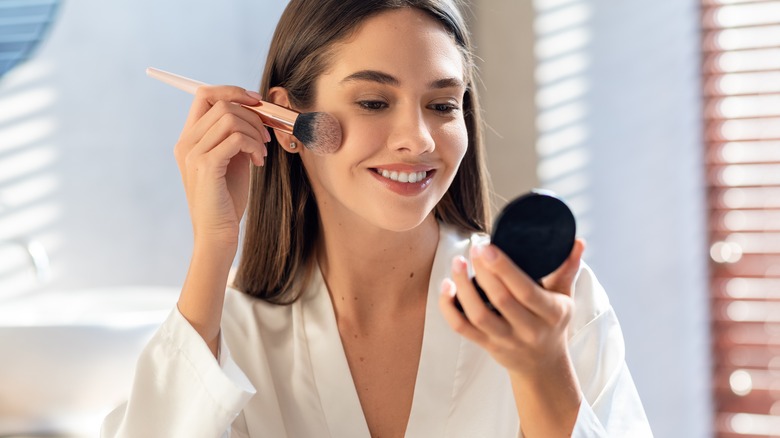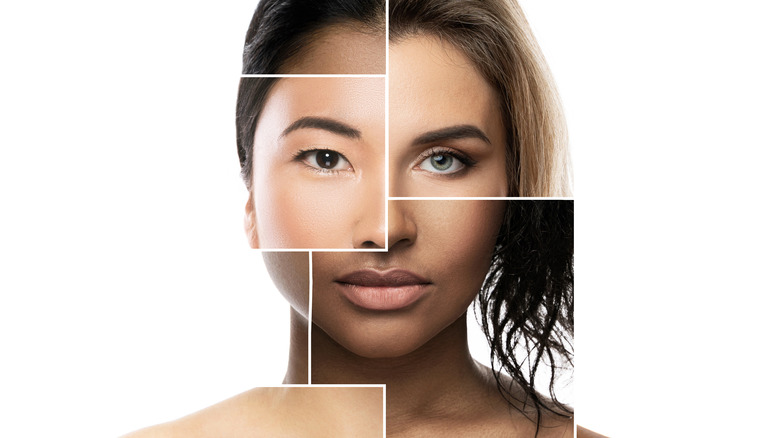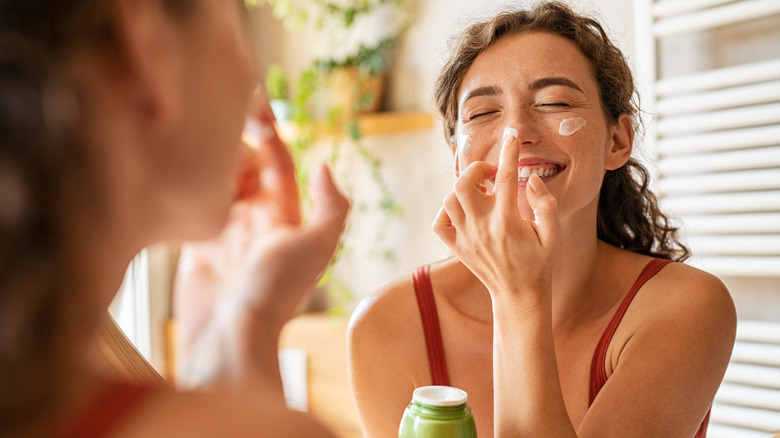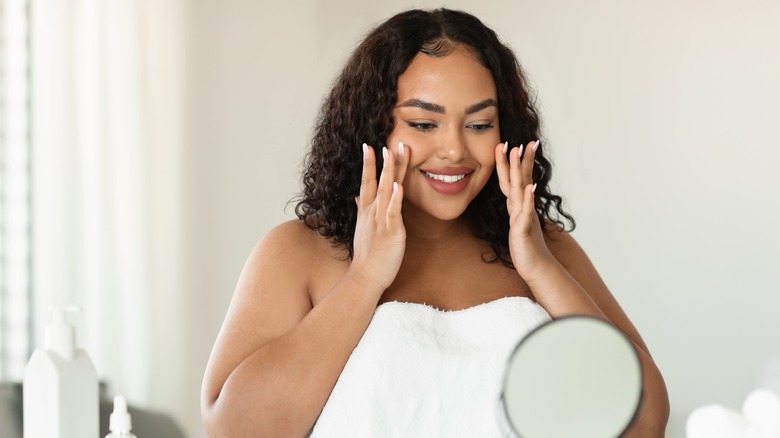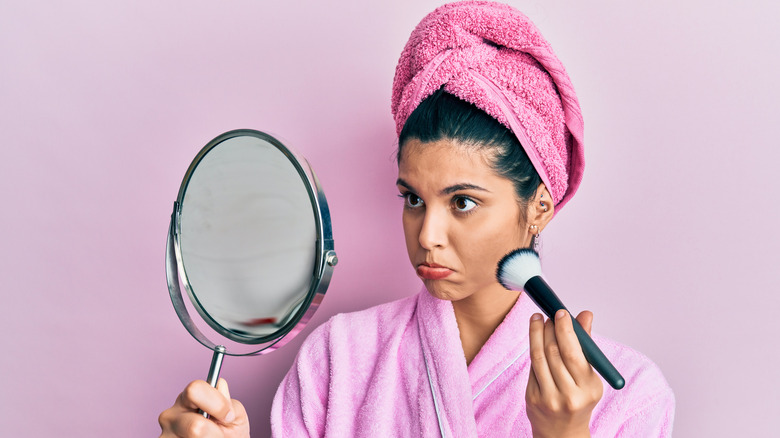How To Master Matte Makeup For When You Don't Want To Look Too Glowy
Makeup trends come and go. Remember when blue eyeshadow was all the rage in the early aughts? Yeah, well, word on the street is that it's back in style, and it brought butterfly clips, silver smokey eyes, and extremely low-rise jeans with it. (Was anybody else hoping those would stay back there?) Nevertheless, it's always fun to see makeup trends enter and exit the chat over the years, and one trend that had its moment back in 2016 that's dying to make a comeback is matte makeup.
Sure, glowy skin is a popular choice, especially during the summer, with viral "wet makeup looks" and "glazed donut skin" prompting makeup-wearers to ditch their matte foundations for a barely-there appearance. However, matte makeup holds a special place in many hearts for its ability to effectively conceal imperfections, give an airbrushed appearance, and last all day. Plus, matte makeup is especially great for those with oily or acne-prone skin (via Ipsy).
One drawback to wearing matte makeup, though, is that it can often look cakey and overdone. Worried that will be you? Don't worry: we have tips so you can master the art of matte makeup for those days when you just don't want to look too glowy.
Is your skin type suitable for matte makeup?
You'll be happy to know that anybody can pull off matte makeup, regardless of tone. However, knowing your skin type will help you understand better how the outcome may turn out. Because matte makeup can be heavy and drying, it may not be a good fit for those who struggle in the dry skin department. Celebrity makeup artist Robin Black told Byrdie, "People with dry, heavily textured or wrinkled skin should be careful with matte foundation."
This is because matte makeup tends to settle into fine lines and cling to dry patches. However, that doesn't mean you can't rock it! With the proper skin prep and products, you can achieve the matte makeup look of your dreams. Let's get into that!
Skin prep is important
Prepping the skin is essential for any makeup application, especially matte makeup. Mega-popular makeup brand Anastasia Beverly Hills recommends not only thoroughly cleansing the skin before application but also exfoliating it. That way, all those dead skin cells and rough patches can be smoothed out for an even application. After that, you should always apply a moisturizer. You can use a hydrating serum, cream, oil, or whatever you prefer, as long as it provides a moisturized base for heavy matte makeup to lay on top of.
Once your face is cleansed and moisturized, apply a primer to take that base one step further. Since you are going for a matte look, opt for a mattifying primer that will subdue your natural shine and blur your pores. However, the best thing you can do is play around with different primers until you find one that works best for you and your skin type. After all, not all skin — or primer — is created equally.
Choose the right products
Just because a makeup product is marketed as a "matte finish" doesn't always mean it's the correct product for your skin type. For those with dry skin, you should reach for a cream or stick formula to prevent any dry skin symptoms from occurring, like flaking (via L'Oréal Paris). If using a cream product, don't forget to set your foundation with a mattifying powder to lock it all in! Conversely, if you have oily skin, try matte foundation powder. The powders will absorb any excess oil your face produces throughout the day, making your application last longer.
When it comes to applying the foundation, you could use a brush, makeup sponge, or your trusty ol' hands. Keep in mind that a wet beauty sponge typically provides a more "skin-like finish," according to The Beauty Editor, which may sheer out the coverage and give a more natural application. We recommend applying the foundation with a brush and then dabbing your makeup sponge after to ensure a seamless finish.
Avoid these common matte makeup mistakes
Matte makeup is often correlated with a thick and cakey finish. But that stereotype is usually a result of using too much product. When it comes to matte makeup, you may want to use a conservative amount, taking the "less is more" approach (via MindBod Green). Some people like to add blush and bronzer on top of their setting powder, which can look like a cakey mess by the end if you use too much, especially if each product provides a matte finish.
You also want to make sure you layer products in the correct order. While you may think applying concealer under your foundation will provide more coverage in those areas that may need it, doing so can cause the concealer to move around, per Marie Claire. To prevent a patchy application, apply foundation, then concealer, and then powder products, and remember to blend your makeup down your neck to avoid the dreaded makeup mask look.
Oh no! It looks cakey. Now what?
You must walk a fine line when applying matte makeup so that the end result doesn't look too overdone unless you're into that kind of look. If you find that your complexion looks too cakey, don't panic — there are ways to fix it. The first thing you can do is reach for a setting spray. They work wonders in adding moisture back into the skin and melting all the products together (via LiveGlam). You could use a matte formula to lock in that matte foundation or a hydrating one for those dry-skin beauties who desperately need a slight shine.
Another tip to soften cakey matte makeup is to pump a few drops of face oil on the back of your hand, dab your damp makeup sponge on the oil, and very gently (and we mean very), pat it on the dry parts of your face. Acting similarly to a setting spray, the face oil will soften the cakeyness and add a bit of hydration to the skin. And if all else fails, rock that super-matte finish knowing you look dang good — because, let's be honest, you do.
